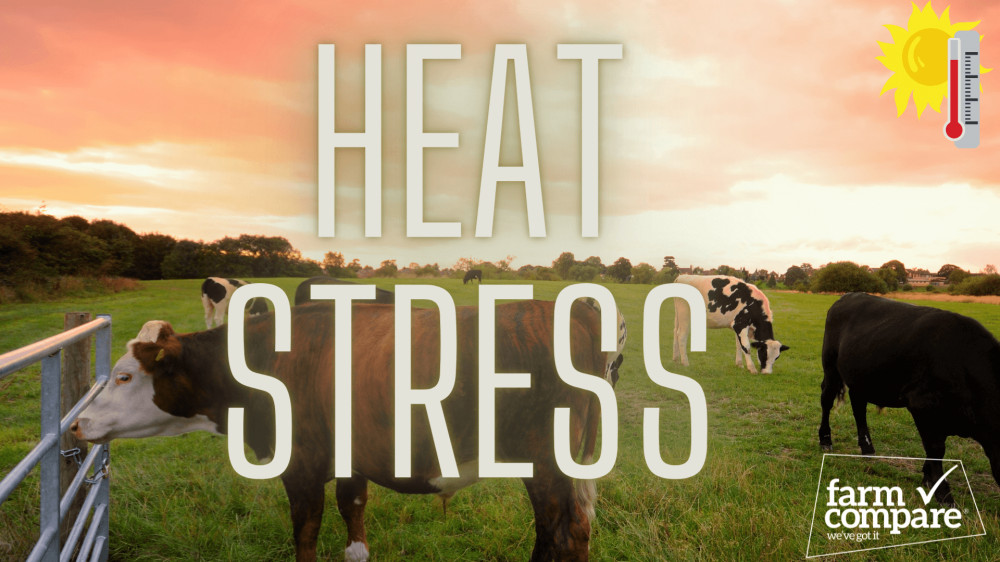How to prevent heat stress in livestock

Warm summer weather may be enjoyable for farmers but can be less so for livestock who are suspetable to heat stress with even a slight increase in air temperatures. Some livestock tolerate heat better than others. Sheep and goats tend to be less susceptible to heat stress than cattle. During periods of extended heat and humidity look out for some of these tell-tale signs of heat stress to look out for include:
1. Change of feeding pattern
2. Lethargy and inactivity
3. Elevated breathing pattern
4. Cattle will often stand with their heads bowed
5. Cattle standing rather than lying down
6. Increased water intake
7. Reduced feed intake
8. Bunching or congregating in the shade if it is available
Farm Compare have summarised some simple tips on preventing heat stress in your livestock.
Improve airflow & ventilation:
Beef cattle at the finishing stage are susceptible to heat stress, because they have the smallest lung capacity relative to bodyweight. Dairy cattle can suffer from a decrease in milk production levels and lowered conception rates, due to high stress hormone levels depressing intakes.
Tip:
1. Replace doors with gates
2. Take out alternate boards on spaced boarding
3. Fans can be used where no other improvements can be made
4. Installation of Calf Ventilation Systems are ideal- Need to source one? Click here to find our more
Providing adequate drinking water
Providing additional water supply is vital when demand is higher on hotter days as water intake can rise by 10-20%.
Tip
1. Place extra drinking troughs to avoid livestock queuing up at troughs.
2. Placing the water troughs in the shade especially the metal ones to allow the water to have a cooling effect on the livestock.
3. Locate the drinking troughs closer to minimise the walking distance.
Feeding
Rumen fermentation can be an underlying reason why some livestock are prone to heat stress – normal digestive processes create heat and this reaches a maximum several hours after feed is consumed.
Tip
1. Move feeding time for indoor systems to late afternoon or evening to allow fermentation during the cooler night temperatures.
2. Feed at cooler times of the day
3. If feeding livestock several times a day, consider providing the largest proportion of the ration in the evening.
4. Review the mineral content of feed to ensure that the minerals lost in sweat in hot weather are replaced.- Maybe you need to review your livestock mineral intake check out animal nutrition for minerals and automated mineral dosing systems here
Handling
Handling livestock during the hottest parts of the day can increase their body temperature as a result of the stress and physical activity.
Tip:
1. Restrict handling if possible and if necessary, carry out early morning or late evening.
2. Remember that when handling the livestock that they need space for cooling in those pens, so be mindful of overcrowding, try and limit time in those pens to under an hour and don’t forget they’ll need access to water during that time.
Farm Compare are working on adding livestock handling products, are you a manufacturer? Get in touch to have your product featured on our site.
Ensure they can shade from the sun
Shade is particularly critical for livestock but identify which of your livestock are at high risk. Young animals, heavy fleshy cattle, pregnant cattle, dark coloured animals and sick animals are generally at high risk of heat stress.
Tip:
1. Adapt paddock layout when grazing if you have fields subdivided into paddocks to create grazing blocks with no trees or hedges for shade, rotate in times of high heat to ensure access to shade. Do you need new electric fencers? Check out the Cheetah Electric range we have on Farm Compare here
Transporting
Heat and humidity make transporting livestock especially stressful even for short trips between farm locations, so keep an eye on these tips and the weather forecast and plan accordingly. Using a trailer like Ifor Williams, Johnston Bros and Bracken Enterprise trailers that have light-coloured roof to reflect away some of the sun’s heat. Bracken Enterprise cattle trailers offer the option to remove the tarpaulin roof.
Tips:
1. Avoid the hottest hours of the day and consider transporting animals at night, even on short journeys.
2. Aim to handle the livestock as little as possible and treat them with care to avoid major disturbance during loading, carriage and unloading.
2. Plan your journey to ensure you can stop and inspect the livestock frequently for the tell-tale signs of heat stress.
3. Livestock will overheat if packed together too tightly so consider reducing your loading density and make sure there is enough space for all animals to regulate their body temperatures.
4. Make full use of the vent and fold down flaps. Check out Farm Compare's video demonstrating the ease of adjusting the fold down flaps and vents rails of Ifor Willaims trailers. Even better make full use of the removal roof covering on the Bracken livestock trailer.
5. Where possible park in the shade, ideally with the vehicle positioned across the prevailing wind.
Heat stress lowers the natural immunity of livestock, making them more susceptible to disease. They will have less tolerance for parasitic and other opportunistic diseases. Always remember that during periods of high heat and/or humidity, livestock should be checked frequently for signs of heat stress.
As farmers, we know this is all common sense but just sometimes it is good to get a reminder.
/banner%20footer.png)
© 2025 Farm Compare Ltd. All rights reserved| T&Cs | Privacy policy | Website by Reflex Studios

This website was developed with support from Priority 6 (LEADER) of the Northern Ireland Rural Development Programme 2014-2020 by the Department of Agriculture, Environment and Rural Affairs and the European Agricultural Fund for Rural Development: Europe investing in rural areas

